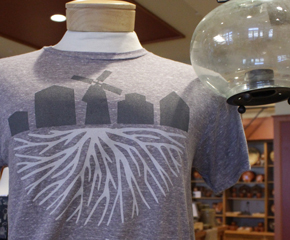
Actions of Innovation
Define: Achieving Clarity
Grades 2-5
Science, English Language Arts, Social Studies
Driving Question
When working through the “Define” phase of an innovation journey, how can students define a specific problem or need to address?Learning Objectives
Students will be able to:- Collect research, data and observations on a possible problem or need to solve.
- Determine what information is valuable and what is not.
- Organize their research to discover and define a specific problem or need.
- Understand the importance of identifying a single need to address, as opposed to attempting to address multiple needs at once.
Why This Matters
Teaching students to be deliberate in their organization of information and research will guide them to make logical, thoughtful conclusions about what they learned. Using a visual organizer, like a concept map, students will see topics in multiple ways and draw meaningful connections between ideas that may not have been evident before. Concept maps can be easily modified to meet student and topic needs.
Standards
Common Core: CCSS.ELA-LITERACY.RI.2-5.3, CCSS.ELA-LITERACY.W.2-5.7, CCSS.ELA-LITERACY.SL.2-5.2; NGSS: 3-5-ETS1-1; NGSS: 3-5-ETS1-2;C3 Framework: D2.His.10.3-5; D2.His.14.3-5, D3.1.3-5, D3.2.3-5.
Prep Activities
Students will analyze and discuss a content-related image that exemplifies a problem or need and begin extracting information and observations to understand the value of organizing information.
Core Activities
Formative Performance Task:
Students will create a concept map that organizes their research, data and observations. Students will analyze their concept map to define a specific problem or need to address.Follow-Up Project
Students will explore other forms of concept maps.Model i
Throughout this lesson, there will be opportunities to practice and develop Model I’s Habits of an Innovator and Actions of Innovation. Listed below are the Habits and Actions that students will be developing and practicing.Developing Habits of an Innovator
-
Stay Curious
Students will explore and research a topic. - Collaborate
Students will work together to design a concept map. - Challenge the Rules
Students will challenge the rules as they discover new relationships and connections in their research. - Take Risks
Students will think BIG as they define a specific problem or need to solve.
Practicing Actions of Innovation
- Uncover
Students will gain insight and a deeper understanding for a problem or need. - Define
Students will use their new perspectives to name a specific problem or need.
Prep Activities
Display a photograph or image that reflects a content topic you are exploring in the classroom.
An example photograph, “Spraying Apple Trees c.1925” can be found here.
Or use The Henry Ford’s collections to find a photograph here.
Ask students – What is happening here? Be sure students support their observations with evidence.
Record student responses where everyone can see them.
Once students have shared a dozen or so comments, point out that some items relate to others and could be grouped together.
- Mark items that are similar using the same symbol.
- For example: If using The Henry Ford image “Spraying Apple Trees,” some comments might relate to the safety of the men and animals - circle them. Other comments might all reflect the chemicals used - place a star next to them. Etc.
- Many concept map examples can be found with a quick internet search.
Core Activities
Formative Performance Task:
Explain to students that they will create their own concept map on the Pre-Activity image.
- Or if students are comfortable, teachers can select a research topic of their choosing, though students will need to have completed some research prior to beginning the concept maps.
Working in small groups and using large newsprint paper, instruct students to write the topic of their research in the middle of the paper. Then, draw a large circle around it.
- For example: “Spraying Apple Trees”
Instruct students to add “Big Idea” bubbles around the center topic. These are the similarities identified in the Pre-Activity.
- Draw circles around these Big Ideas.
- Connect each to the center topic circle with a line.
- For example: Students could write “Safety,” “Animals”, “Bugs,” and “Chemicals”. Then each word would be circled and connected to the center topic bubble.
Then, focusing on each “Big Idea Bubble”, write some details or information that relates to the Big Idea around the bubble.
- Students will circle these words and call them “Detail Bubbles.” Connect these details to the Big Idea circle with lines.
- For example: Students might write details such as, “Men breathing chemicals” and “Men eating chemicals on apples” around the Big Idea Bubble of “Safety.”
- Depending on the students, teachers can make this as detailed or broad as needed.
Once complete, have students evaluate the concept map. Answer questions like:
- What did you learn about this topic by organizing your research?
- Does it look like there is an area where you might need more information?
- What do you wonder now that you see your topic in this visual way? Students can add “Question Bubbles” to the concept map.
Explain to students that it’s now time to define one, needs-based actual problem. Explain to them that they cannot solve all the problems at once.
- Using their concept map information, can they identify a single problem or need that they could attempt to act on?
- At first, students might identify several problems or needs. Guide them in choosing just one.
Guide them in choosing just one by focusing on ideas, such as:
- Is this a reasonable problem to try to solve?
- Do materials exist that could help me solve the problem?
- Are there people who could help me or give me advice?
Write this problem or need on the concept map.
- Encourage students to stay focused on identifying the problem or need. They are not yet stating HOW they would solve it.
- For example: Students might suggest solving the problem of horses breathing in chemicals, men breathing in chemicals, or people eating the chemicals with the apples. But solving all three at once would be difficult and confusing. Picking just one will help students stay focused in the next innovation phase: Design a solution.
Enrichment Challenges
To make the map more visual, different colored markers or crayons could be used for each level of the concept map. For example, red for the Topic Circle, Blue for the Big Idea Bubbles, Orange for the Detail Bubbles, and Purple for the Question Bubbles.
Students could write on the connector lines HOW the big ideas relate to the topic and HOW the “Detail Bubbles” relate to the “Big Idea Bubbles.”
As students work through each part of the project, encourage them to reflect on how they are using or might use the Model i Habits and Actions to guide their project building.
Follow-Up Project
If time permits, have students share their concept maps with the class or another group. Point out that there is more than one “right way” to make a concept map.-Classmates can suggest additional Big Idea, Detail, or Question Bubbles to add.
Teachers can search the internet for more examples of concept maps, showing students that the format can change and the maps can be organized differently to help the student make sense of their information.
Standards
Common Core State Standards In English Language Arts
CCSS.ELA-LITERACY.RI.2-5.3. Describe the connection between a series of historical events, scientific ideas or concepts, or steps in technical procedures in a text.CCSS.ELA-LITERACY.W.2-5.7. Participate in shared research and writing projects.
CCSS.ELA-LITERACY.SL.2-5.2. Recount or describe key ideas or details from a text read aloud or information presented orally or through other media.
Next Generation Science Standards
3-5-ETS1-1. Define a simple design problem reflecting a need or a want that includes specified criteria for success and constraints on materials, time or cost.3-5-ETS1-2. Generate and compare multiple possible solutions to a problem based on how well each is likely to meet the criteria and constraints of the problem.College, Career and Civic Life (C3) Framework for Social Studies State Standards
D2.His.14.3-5. Explain probable causes and effects of events and developments.
D3.1.3-5. Gather relevant information from multiple sources while using the origin, structure, and context to guide the selection.
D3.2.3-5. Use distinctions among fact and opinion to determine the credibility of multiple sources.


